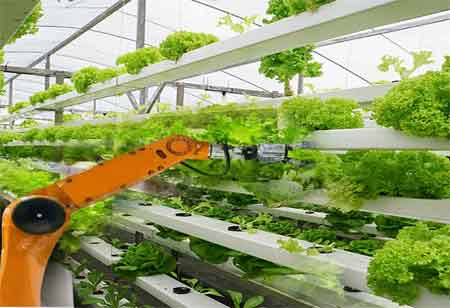Thank you for Subscribing to Agri Business Review Weekly Brief
Advantages of Aquaponics
Aquaponics is a system in which traditional aquaculture (raising fish, prawns, snails) is coupled with hydroponics (cultivating plants in water without soil) in a synergetic environment.

By
Agri Business Review | Thursday, November 17, 2022
Stay ahead of the industry with exclusive feature stories on the top companies, expert insights and the latest news delivered straight to your inbox. Subscribe today.
Aquaponics is a system in which traditional aquaculture is coupled with hydroponics in a synergetic environment.
FREMONT, CA: Aquaponics is a system in which traditional aquaculture (raising fish, prawns, snails) is coupled with hydroponics (cultivating plants in water without soil) in a synergetic environment. Aquaculture is the breeding of aquatic animals like fish, prawns, crayfish, and so on, while the hydroponic system is farming plants in water without soil.
Nonetheless, the fish provide wastes that act as a source of organic nutrients for plants. Conversely, the plants act as natural water filters. And aside from the fish and the plants, the third major factor is the microbes.
These nitrifying bacteria assemble between the root spaces of the plants and transform the ammonia released by the fish waste into nitrites and then to nitrates which are then engrossed as nitrogen by the plant. The nitrifying bacteria also transform the solid fish waste into a form called vermicompost, which acts as plants' food.
The combined system is a form of recoverable crop production and water conservation. The combination of the aquaculture and the hydroponic systems ensures that aquaponics capitalizes on the benefit of both and eliminates any drawbacks of the individual system.
Advantages of Aquaponics
1. Grow both vegetables and fish. In an aquaponic arrangement, one can grow vegetables and, at the same time, rear fish. Furthermore, the system is completely symbiotic, where the fish gives the nutrients to the plants, and consecutively, they get their water purified.
2. The system does not ask to use fertilizers or any agricultural chemicals since the wastes from the fish have sufficient nutrients.
3. Negligible amount of water is used. This system uses a small quantity of water to maintain the plant. Hence, the system conserves water. Along with the conservation, the water is recycled.
4. Crops are completely organic. The crops cultivated are completely organic, and the fish are free from any damaging or toxic chemicals
5. Usage of a small space. One can cultivate an incredible amount of crops in a very small space
6. Rapid growth pace of crops. The growth pace of the crops is fast due to the adequate amount of nutrients that are made open to them.
7. Cultivating crops and fish in a controlled and closely observing environment. The production of crops and fish is performed in controlled conditions where temperature, among other factors, can be controlled
8. Healthy environment. There are no possibilities of soil-borne diseases, pests, and infections as the soil are not used in the system.
9. No weed buildup. Due to its waist-high gardening, the aquaponic system has no accumulation of weeds.
10. Minimal garden works. The garden works are minimal compared to conventional methods of farming. The only tasks are feeding the fish and ensuring the system operates effectively.
11. Flexibility of the farming method. The farming method can be practiced anywhere because of the limited space needed to run it.
12. Scalable farming system. The system is scalable and does not need a lot of capital to initiate and run. One can start it in the backyard.





